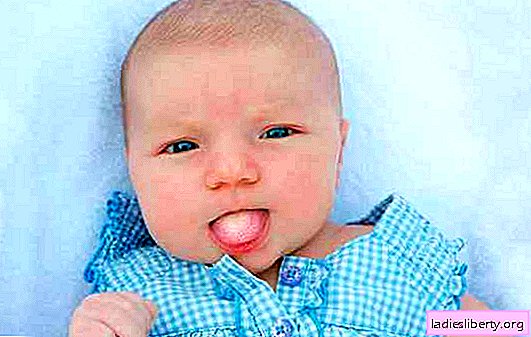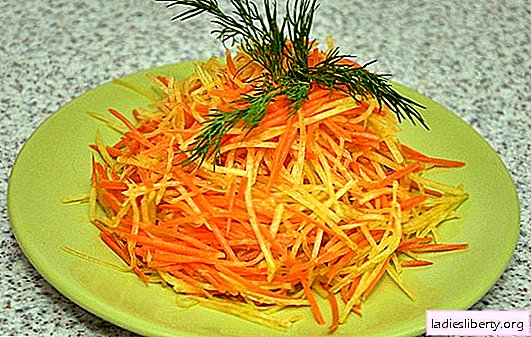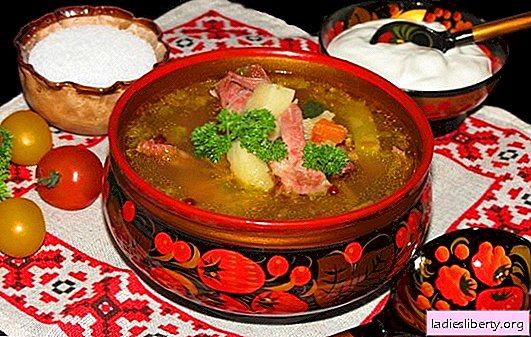
Everyone knows that the tongue is an indicator of the state of not only the digestive organs, but also the health of the whole organism as a whole. By his appearance, one can understand how far the pathology has gone, and how urgently it is necessary to take appropriate measures.
Often the cause for parental concern is the white tongue of the newborn, which normally should be pink, clean, smooth and moist, with even papillae along its surface.
There are many reasons leading to the appearance of white plaque and you need to know them in order to understand how serious this problem is and what actions need to be taken.
Physiological causes of the appearance of a white tongue in a newborn
The causes of the white tongue in the newborn are divided into physiological and pathological. Normally, a child develops
plaque after the next feeding. Most often this occurs in children who are fed infant formula. Some of these mixtures are capable of forming an even translucent coating on the palate, gums, and mucous surfaces of the cheeks. As a rule, plaque is immediately washed off with water and does not cause any consequences.
The tongue is covered with plaque and after breast milk. After a while, it cleans itself. But after breastfeeding, only the tongue turns white - plaque does not appear in other places. A pink mucous membrane appears through the film, and if you give the child a little water, the film disappears.
Pathological causes of white plaque in the tongue of a newborn
The pathological causes of the appearance of a white tongue in a newborn often require not only the attention of parents, but also an immediate examination by a pediatrician. This can be a serious pathology of the internal organs or a manifestation of infections. These reasons include:
- digestive disorders (constipation; dysbiosis after taking antibiotics for a disease; feeding with mixtures or products that are not appropriate for age);
- childhood infections (chickenpox, scarlet fever, measles), accompanied by stomatitis and the formation of a white tongue and oral mucosa;
- fungal lesions;
- other infections (SARS, tonsillitis);
- allergies, which often leads to the use of antibiotics;
- hypovitaminosis;
- anemia;
- diabetes.
What to do when a white coating appears in the tongue of a newborn
In all of the above cases, in addition to the appearance of a white tongue in a newborn, there are other signs that should alert parents. An infectious disease that a child can fall ill with is accompanied by symptoms, fever, intoxication, characteristic of each infection. Immediate consultation with a doctor is necessary, since self-medication can worsen the situation. In addition, the specialist will assess the condition of the newborn: hospitalization may be required.
With a revealed pathology of the digestive system, it is necessary to treat the underlying disease. After treatment, a plaque in the tongue disappears.
If it turns out that the cause of the white tongue became errors in nutrition, it is necessary to consult with the pediatrician again. It may be necessary to change the mixture if the child is breast-fed, strictly adhere to the regime: observe the feeding time and the amount of food, review the introduction of complementary foods.
White tongue in a newborn is a sign of dysbiosis
Significant disturbances in the body occur in connection with the development of dysbiosis, which becomes the result of disturbed acid - base balance in the intestine and the rapid reproduction of the conditionally pathogenic flora, which manifests its pathogenic properties. White tongue in a newborn with dysbiosis has its own distinctive features:
- all language is completely covered by a raid;
- plaque with dysbiosis is thick, the mucous membrane does not shine through it, it is not washed off with water;
- plaque thickness increases with the development of the process and the weight of the state;
- the appearance of a white tongue in a newborn with dysbiosis can be accompanied by a simultaneous rash on the body;
- accompanied by impaired stool (diarrhea, constipation), abdominal pain, refusal to eat, constant crying and anxiety of the child.
A pediatrician consultation is needed to clarify the diagnosis and appropriate treatment. It is impossible to self-medicate in such cases so as not to aggravate the condition of the child.
Viral stomatitis: a possible cause of white tongue in infants
The white tongue in childhood airborne infections (measles, scarlet fever, chicken pox) is characterized by the development of the plaque itself, its localization and appearance:
- a white lumpy coating appears first on the mucous membrane of the palate and cheeks, and only later - on the tongue;
- plaque cannot be completely removed: hyperemia and a painful bleeding surface remain in its place.
The general condition of the child eventually becomes severe with all manifestations of the underlying disease. Treatment takes place in a hospital or at home under the supervision of a pediatrician.
Other causes of white tongue in a baby
With an incorrect development of the nervous system, which leads to neurosis in the future, the white tongue in a newborn is characterized by an uneven plaque, thickening to the edges and more transparent to the middle.
When intoxication occurs due to improperly selected mixtures or complementary foods, the white tongue is covered with a thick coating mainly at the root of the tongue and adjacent lateral surfaces. This condition is often accompanied by vomiting or diarrhea.
In diabetes mellitus, due to dry mouth, the protective properties of the mucous membrane are reduced. Timely detection and treatment of the disease is necessary.
Candidiasis stomatitis is a common occurrence in newborns
In cases where stomatitis with a white coating on the tongue is detected, the pediatrician will differentiate the viral etiology of the disease from fungal and prescribe the necessary treatment in a timely manner.
Candidiasis stomatitis - a phenomenon in children under the age of 6 months is very common. Fungi of the genus Candida albicans, causing candidiasis, or thrush, are found in the body of almost every person, since they belong to the conditionally pathogenic microflora. Not everyone gets sick, but only people with weakened immune systems. Since immunity is not fully formed in newborns, fungal infection can occur during childbirth or after it from the mother, and also later through a toy, pacifier, other objects that can fall into the hands or mouth of the baby.
In addition to weak immunity, the ability to produce saliva is not fully formed, and therefore a small amount of lysozyme and its low activity cannot provide sufficient protection against pathogenic or a large number of conditionally pathogenic microflora.
Distinctive features of thrush
The white tongue with thrush has distinctive features. If you know them, confusing candidiasis with another pathology is difficult. Candidiasis plaque:
- looks like a thick curd mass;
- covers the tongue, cheeks, gums with a continuous layer or in separate sections, can also be on a hard palate;
- when removed, it separates painfully, with difficulty, leaving behind a bleeding surface.
With thrush, the child’s behavior also changes: he becomes moody, restless, may refuse to eat, sleeps poorly.
How to prevent candidiasis in a child
In order to avoid candidiasis, you need to understand the mechanism of its development. As a rule, thrush develops if the child is in hot, dry air, often spits up, drinks little water. In order to prevent the propagation of fungi, it is necessary:
- after feeding, give a small amount of clean water (several teaspoons) to wash away from the tongue the remnants of breast milk or the milk mixture, which are a good substrate for the life of the mushrooms;
- humidify the air to 50 - 70%, if necessary, use a humidifier;
- give the child a sufficient amount of water, especially in the hot season, to avoid dry mucous membranes, preserve their protective properties and not create additional conditions for the reproduction of mushrooms;
- Be sure to give water after each regurgitation;
- since fungi of the genus Candida do not exist in an alkaline environment, it is necessary to wipe the tongue and the oral cavity of the child with a wet soda cloth when a thick coating appears on them. Soda solution is prepared simply: a teaspoon of soda in 200 ml of water. To process up to 5 times a day with a gauze swab dipped in solution, without using force and without tearing off the coating. It is not recommended to do this more often, so as not to kill the normal microflora and not reduce that child’s immunity. At the same time, the nursing mother should also carry out the same measures: treat the baby’s nipples, toys and pacifier with this solution, all objects that can fall into the hands or mouth of the newborn.
If these measures are ineffective, the pediatrician decides on the treatment of antifungal agents. They are assigned simultaneously to the child and mother.
Thus, a white tongue in a newborn can be a manifestation of various pathologies or a variant of the norm.
It all depends on attentiveness to the child, timely detection of signs of the disease and contacting a pediatrician. Only a doctor can decide how serious the problem associated with the appearance of a white tongue in a newborn is, and what actions should be taken. You can not risk the health of the child and self-medicate.











